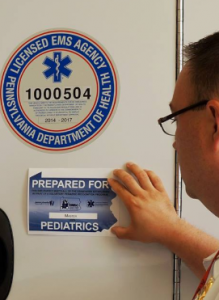About the PA EMSC Program
About Us
The Federal EMS for Children Program is designed to ensure that all children and adolescents, no matter where they live, attend school, or travel, receive appropriate care in a health emergency. Since its establishment in 1985, the EMSC Program has provided grant funding to all 50 states, the District of Columbia, and five U.S. territories.
Today, most Federal EMSC funding is administered through either a State Partnership or Targeted Issue grant. Pennsylvania’s EMSC program is just one of more than fifty State Partnership grants currently awarded. More information on each of these programs can be found at the Federal MCHB HRSA website: http://mchb.hrsa.gov
This project is supported by the Health Resources and Services Administration (HRSA) of the U.S. Department of Health and Human Services (HHS) under the Emergency Medical Services for Children State Partnership grant program, Grant # H33MC06717, for $130,000 annually. This information or content and conclusions are those of the author and should not be construed as the official position or policy of, nor should any endorsements be inferred by HRSA, HHS or the U.S. Government.
Additional funding and support for this project is made possible through a contract with the Pennsylvania Department of Health, Bureau of Emergency Medical Services.
In addition to funding State Partnership and Targeted Issue grants, the EMSC Program also provides funding for two support centers and one research branch:
- The EMSC Innovation & Improvement Center (EIIC) – https://emscimprovement.center/
- The EIIC, established in 2016, focuses on accelerating improvements in quality of care and outcomes for children who are in need of urgent or emergency care through an infrastructure that ensures routine, integrated coordination of quality improvement activities between key stakeholder organizations and their champions.
- The National EMSC Data Analysis Resource Center (NEDARC) – www.nedarc.org
- NEDARC provides technical assistance to EMS agencies and EMSC grantees in developing their data capabilities. Located at the University of Utah School of Medicine, NEDARC was created in 1995 to address priorities in EMSC data collection. NEDARC hosts annual workshops, which are attended by members of Pennsylvania’s EMSC program, to enhance the Commonwealth’s EMSC efforts through improvements in data collection, data reporting, grant writing, and social media. NEDARC also provides direct support to Pennsylvania in collecting data for the EMSC Voluntary Recognition Program.
- The Pediatric Emergency Care Applied Research Network (PECARN) – www.pecarn.org
- PECARN is the first federally-funded pediatric emergency medicine research network in the United States. PECARN conducts high-priority, multi-institutional research on the prevention and management of acute illnesses and injuries in children and youth of all ages.
Pennsylvania’s EMSC State Partnership grant is awarded to the Pennsylvania Department of Health. The Pennsylvania Emergency Health Services Council (PEHSC), as a part of their contractual partnership with the Department of Health, manages most aspects of the EMSC grant by employing a project manager and operating an EMSC advisory committee. Pennsylvania has held an EMSC State Partnership grant almost continuously since the Federal program was established in 1985.
MEETING SCHEDULE
All PA EMSC Advisory Committee meetings are open to the public; if you wish to attend, please e-mail dspencer@pehsc.org for call-in instructions for conference calls or information regarding the location of the in-person meeting.

TTuesday February 27, 2024
Tuesday May 28, 2024
Tuesday September 10, 2024 In person
Tuesday November 26, 2024
All meetings begin at 10:00 am and are being held via conference call/webinar unless noted otherwise.
LEADERSHIP & MEMBERSHIP
The EMSC Advisory Committee has been established to serve as a forum for issues that have potential impact on the emergency care and transport of all pediatric patients in the Commonwealth. The committee formulates recommendations to the Board of Directors of the Pennsylvania Emergency Health Services Council (PEHSC) which reflect the interest and opinion of pediatric emergency care and injury prevention professionals. Through the work of this committee, education is provided to EMS providers, other healthcare practitioners, and the general public in regard to provision of
EMSC Physician Advisor – Sylvia Owusu-Ansah, MD, MPH
EMSC Project Director – Jay Taylor
EMSC Program Manager/Staff Liaison – Duane Spencer
EMSC Advisory Committee Chairperson – Open
Family Advisory Network Representative – Josh Stuart
For information on participating on the EMSC Committee, please visit the Get Involved tab of this website.
COMMITTEE MEMBERSHIP
COMMITTEE STRUCTURE
Committee Purpose
 To serve as a forum for issues that have potential impact on the emergency care and transport of all pediatric patients in the Commonwealth; to educate prehospital providers, other health practitioners and the general public in regard to provision of services available through the emergency medical services for children program; to formulate recommendations to the Board of Directors of PEHSC which reflect the interest and opinion of pediatric emergency care and injury prevention professionals.
To serve as a forum for issues that have potential impact on the emergency care and transport of all pediatric patients in the Commonwealth; to educate prehospital providers, other health practitioners and the general public in regard to provision of services available through the emergency medical services for children program; to formulate recommendations to the Board of Directors of PEHSC which reflect the interest and opinion of pediatric emergency care and injury prevention professionals.
Committee Composition
Membership in the EMS for Children Advisory Committee has no stipulation. Physicians, nurses, healthcare professionals, prehospital providers, injury prevention advocates and, most importantly, PARENTS may make up the general body of this committee.
The Committee Chairperson is responsible to the PEHSC Board of Directors to present activities and recommendations of the EMSC Advisory Committee and participate in deliberation(s) and discussion(s) with other committees and/or taskforces to ensure that the needs of the pediatric population are met at the statewide level. The committee composition and reporting requirements to the PEHSC Board of Directors are guided by the Federal EMS for Children State Partnership Grant.
In addition to the designation of a committee chairperson(s), a family representative (as defined by the Federal EMSC Program), and a committee medical director (EMSC Physician Advisor) shall be identified. The EMSC Physician Advisor shall provide physician input in committee discussions and serve as a liaison between the EMSC Committee and the Medical Advisory Committee (MAC).
Appointment Process
- Those names which appear on the current mailing list shall automatically be considered members until further notice, or the member meets the following criteria:
- the member submits a written resignation to the chairperson.
- the member misses three or more meetings within the fiscal year.
- Written requests for membership shall be submitted to the committee chairperson for consideration at the next regular meeting.
- Resigned positions will not automatically be replaced.
- Appointment letters will be mailed to the committee nominee asking that they indicate their willingness to serve on the committee.
- Task forces and subcommittees will be appointed at the discretion of the chairperson in order to accomplish the objectives of the annual work program and other designated projects. Non-committee members may be appointed to such subcommittees but will not then be considered members of the EMSC Advisory Committee
- Visitors are welcome to attend any regular meeting, but may not vote.
Committee Responsibilities
The Committee, relying on the expertise of its members, considers issues and develops recommendations for consideration by the Board of Directors. A recommendation approved by a simple majority committee vote is transmitted to the Board as a Vote to Recommend (VTR). A clarifying statement or rationale developed by staff and the chairs should be written for each VTR and provided to the Board. VTRs approved by the Board are forwarded to the Pennsylvania Department of Health as official PEHSC positions on EMS issues.
All Committee recommendations maintain a “draft” status and cannot be represented as the official position of PEHSC until approved by the Board of Directors.
When indicated, the Committee develops position statements on various issues to provide guidance to the Board of Directors and EMS community. Position statements are generally drafted following each meeting by staff, based on VTRs and discussion points generated by the Committee members. Position statements are usually developed for proposed legislative issues, although they may be required for other situations as indicated by the Committee chair.
Chair Responsibilities
The chair is expected to run each meeting in an effective and efficient manner. Chairs should have an understanding of parliamentary procedure and Robert’s Rules of Order and be able to apply proper procedure when necessary.
The chair should strive to keep each meeting focused on the agenda items, with a bias toward action and completion of the tasks to be accomplished. Chairs should not hesitate to refer a matter to a subcommittee, task force, or other PEHSC committees, but should recognize the point when enough productive thought and discussion has occurred and the time has arrived to make a decision and put the matter to a vote.
Chairs should attend the meetings of the Board of Directors and provide updates of Committee activities. When the Committee has developed VTRs, the chairs should be prepared to present them and explain their underlying rationale.
Chairs should maintain liaisons with the Council President and staff regarding Committee projects and progress. Chairs should be available to consult with staff on issues such as agenda planning, Committee document preparation, and other issues.
Member Responsibility
Committee members are expected to attend the meetings and participate in all discussions and deliberations, demonstrating a high degree of interest, commitment, and genuine concern for the improvement of EMS.
In order to maintain active status on the Committee, members may not miss more than three scheduled meetings in the EMSC fiscal year (March-February). Members with more than three unexcused absences will be subject to dismissal. There is a great amount of work to be accomplished by the Committee, and membership appointments must be made to achieve maximum productivity.
Members receive meeting notices and agendas approximately 30 days prior to each scheduled meeting. Members who must change their plans regarding meeting attendance should notify the Council office no later than 4 p.m. on the day before the meeting.
Generally, members will receive copies of documents and materials via e-mail or website link for discussion at each meeting. Members should bring all materials to the subsequent meeting to reference during discussion.
Members must advise the Council of any change of address, phone number, e-mail address, or organizational affiliation.
Online or teleconference meetings will be held whenever possible, and live meetings that were cancelled due to inclement weather will be held via a distance-method at the discretion of the committee chairperson and PEHSC staff. In case of inclement weather on face-to-face meeting day(s), members should contact the Council office to determine whether the meeting will be held as scheduled. PEHSC cancels any meeting in which travel conditions may pose a hazard to members.
Committee members are responsible to sign the attendance roster at the meeting. Failure to do so will result in being classified as absent.
The Committee has a multitude of decisions to make in limited meeting time. Therefore, members should avoid lengthy, rambling, or repetitive statements, and concisely state their positions. Members should strive to keep the focus of the debate constructive, rather than argumentative.

